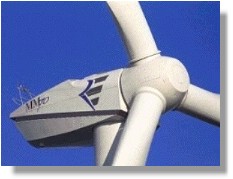The Feasibility of Wind Power for Townsville Based on an examination of the feasibility and economic viability of wind power for the Cleveland Bay Purification Plant by Dr Harry Suehrcke. |

|
- Townsville has commercially viable wind resource - Study based on REpower MM70 (pictured left) - Using data collected by AIMS and processed by CSIRO - Payback in 7.7 years |
With the exception of the occasional cyclone, Townsville is not noted as a particularly high wind area. A study by Notus Energy (2003) of average wind speed at the Townsville Port at 65m above ground level (the rotor hub height of a REpower MM70 wind turbine) calculated an annual average wind speed of 7.1 metres per second (m/s). This speed was extrapolated from a computer model, based on wind speed date collected from the Cleveland Bay AIMS site weather monitoring station. A similar study was undertaken for the Cleaveland Bay Purification Plant site. Here, the average annual wind speed is slightly lower at 6.9 m/s. |
|
Factors to consider in wind turbine economics:
|
The power generated by a wind turbine is highly dependent on wind speed. However, not all wind power can be extracted by a turbine due to the need to maintain an airflow. For example, at a wind speed of 14m/s, a MM70 turbine converts approximately 34% of the wind energy into electrical power. The actual (electrical) power output of the MM70 turbine as a function of wind speed is shown in Figure 1.
Did you know: an average home draws about 1 kW of energy, so two 2 MW wind turbines, when running at full output could power 4,000 homes. Power output could be increased if the turbine was located at another site with higher wind speeds. For example, an increase in wind speed of 1m/s increases the average output from 470 kW to 650 kW (or 32% of maximum output). An increase of 2 m/s increases the output to 856 kW. Turbines are often placed on elevated points, such as on smooth hills, where wind speed is greatest. Trees and other obstacles can negatively affect wind speed. The initial consideration was to locate the wind turbines at the CBPP plant in order to direct feed the power into the system and offset the purchase of electricity from the mains grid. THis would give an economic worth of the wind energy of about 10c per kWh. It is noted that locating the turbines at a site with higher wind speeds (around 8.9 m/s) would significantly increase the power output. However, this may then facilitate the need to sell the power to the local utility and buy it back at the treatment plant. Alternatively, it would be necessary to install a power line between the turbines and the treatment plant that would increase costs and also increase transmission loss through electrical resistance. Using simple economic calculations involving the initial cost of the turbines, annual operating costs, and the value of the power generated, the time taken to repay the initial outlay of two wind turbines at the Cleveland Bay purification plant is 7.7 years. This would mean that, given a 20 year minimum life span of the turbine, 12.3 years of power output would be free excluding minimal maintenance. Key Findings
Repower MM70 - The reliable 2-megawatt power plant with 70 meter rotor diameter (.pdf 328Kb) |